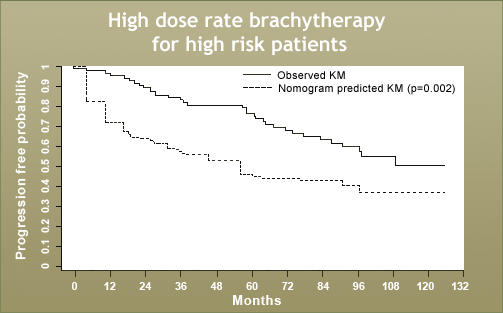Recently we reviewed a group of patients that I had treated between 1998 and 2000. We followed the patients up for a minimum of 10 years and compared it to a similar surgical series. Results were outstanding and in truth out-performed my surgical results in the very high-risk population by about 20% ( these results will shortly be the subject of a publication). It is worth noting, however, that surgery with follow up radiotherapy is challenging these results (see graph below).

Generally, the cure-rate for high-dose rate brachytherapy in combination with external beam radiotherapy depends on how many high-risk factors ( Gleeson score 8-10 , PSA >20 , Clinical stage T3 )are involved. If there is:
- One risk factor – 90% 10-year cure rate
- Two risk factors – 70% Cure rate
- Three risk factors – 60% Cure rate
- Impotence – 50%
- Incontinence – 1%
- Rectal damage – <1%
- Urethral stricture rate- 5%
Once again, high-dose brachytherapy is generally reserved for those patients with extremely extensive prostate cancer where surgical cure is difficult, particularly in more middle-aged and older patients, where urinary symptoms are not dominant and where there is a dominance of apical disease or where I am concerned that the cancer is not resectable.
